Biology
It tends to be male rhino beetles that have horns, and this is the case with the Neptune beetle, which has possibly the most impressive horns of any species.
The male Neptune beetle has a very long horn curving upwards on its head, and another equally long horn fringed with short hairs underneath that emerges from the pronotum (the thorax). By moving it’s head up and down, the beetle can use these horns like a pincer to battle rival males.
In addition, there are two smaller horns on the pronotum projecting forward underneath the main central horn.
The females look quite different, having only a small tubercle on the head and roughened wing cases. Such differences between males and females - sexual dimorphism - are common in many scarab beetle species.
The size of the horns varies according to the beetle’s overall size - smaller beetles have much smaller horns, whereas large beetles can have proportionally much bigger horns. This scaling of horn development to body size is allometrically determined.
Rhinoceros beetles are immensely strong and proportional to their size are amongst the strongest creatures on earth -one popular quote suggests they can carry 850 times their own body weight!
